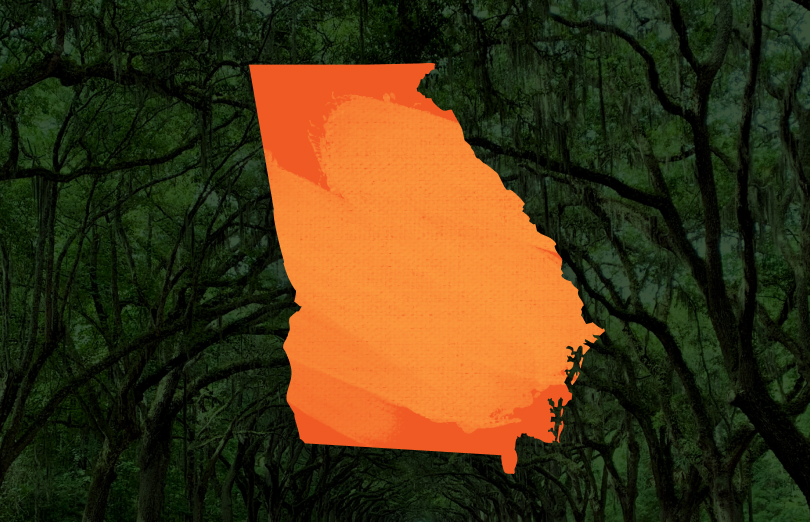How Fair is School Funding in My State?
States must create school funding formulas that are transparent, fair, and clearly provide for the needs of individual students. Using criteria developed based on research, best practice, and what we believe, we provide ratings for each Southern state.
Our goal is for states to build a simplified, student-weighted funding formula guided by students’ different levels of need with the goals of eliminating achievement and opportunity gaps. We aim for states to create adequate, equitable, and transparent formulas that provide clear dollar allocations by assigning additional “weights” for students from low-income families, English learners, students with disabilities, and rural students.
Education Funding by State
Ratings Rubric
| Criteria | Red | Yellow | Green |
|---|---|---|---|
| FUND STUDENTS ADEQUATELY | |||
| The funding formula is student-based, or weighted | Formula is resource- or program-based and allocates resources such as staff, services, or programs based in the form of “units” or ratios of students-to-staff position, or categorical grants that are not tied to actual student needs. | Formula is a hybrid model, combining aspects of a student-based model, resource-based model, and various cost factors. | Formula allocates a base, or defined amount of funding, on a per-student basis and allocates additional money or weights to provide additional money per student with specific needs, such as English learners |
| Per-pupil funding is adequate enough for all students to achieve average, national test scores | There is high percentage (40-100%) of students attending schools in inadequately funded districts | There is moderate percentage (40-10%) of students attending schools in inadequately funded districts | There is a low percentage (0-10%) of students attending schools in inadequately funded districts |
Red | Yellow | Green |
|
| FUND STUDENT NEEDS APPROPRIATELY | |||
| Formula includes a weight or additional funding for students living in poverty | Formula does not include weights or additional funding, includes very low funding (e.g. less than 10% of base amount), or includes flat funding | Formula includes insufficient weights or additional funding (e.g. 10-99% of base amount) | Formula provides generous weights or additional funding (e.g. 100% or more of the base amount) for students living in poverty |
| Formula includes a weight or additional funding for English learners | Formula does not include weights or additional funding, or includes very low funding (e.g. less than 10% of base amount), or includes flat funding | Formula includes insufficient weights or additional funding (e.g. 10-99% of base amount) | Formula provides generous weights or additional funding (e.g. 100% or more of the base amount) for English learners |
| Formula includes a weight or additional funding for students with disabilities | Formula does not include weights or additional funding, or bases funding not on student-based factors (e.g. staff positions) | Formula includes weights or additional funding that is flat or does not differentiate between the types of disabilities students have | Formula includes a system of at least three to five funding tiers in which students are funded based on their diagnoses |
| Formula includes a weight or additional funding for sparse and/or isolated districts | Formula does not include weights or additional funding | Formula includes insufficient weights or additional funding (e.g. 10-99% of base amount) or funding is not differentiated based on sparsity or isolation | Formula includes a generous sliding scale weight for sparsity on a per-student basis and includes a flat weight for districts that are isolated |
| Formula includes weights or additional funding for districts with high levels of concentrated poverty | Formula does not include a weight or additional funding | Formula includes a concentrated poverty weight that is insufficient or is static and not reflective of the needs of districts with higher levels of poverty | Formula includes a generous, sliding scale weight that provides more funding to districts with higher percentages of student poverty |
Red | Yellow | Green |
|
| FUND SCHOOL DISTRICTS EQUITABLY | |||
| State caps how much local revenue districts can raise to limit between-district disparities in local revenue | The state does not impose a cap on how much local revenue districts can raise | The state imposes a cap but voters can override it | The state imposes a cap on how much local revenue districts can raise, and voters cannot override it |
Red | Yellow | Green |
|
| FUND STUDENTS TRANSPARENTLY | |||
| State annually publishes information about how the funding system is designed to work in clear, plain language | System is not summarized (i.e., it’s only described through legislation language etc.) | System is summarized, but the language used is full of jargon and is not understandable by a lay audience; the information is not easily found on the state department of education website | System is summarized in clear, accessible language and can be easily found on the state department of education website |
| State reports school spending data in alignment with equity-oriented principles | State reporting is not aligned with equity-oriented reporting principles | State reporting is partially aligned with equity-oriented reporting principles | State reporting is aligned with equity-oriented reporting principles |
| PUBLIC FUNDS FUND PUBLIC SCHOOLS | |||
| Taxpayer funds are used to maintain and support public schools exclusively | State allows public funds to fund private schooling, such as vouchers and education savings accounts (ESA), with no income eligibility requirements, accountability, or transparency | State limits vouchers or ESAs to families with low-income or students with disabilities with specific service needs that a public school cannot meet, and requires some accountability and reporting | State does not have a publicly-funded private school voucher program or education savings accounts, keeping public education dollars in public school systems |
Funding Justifications
| STUDENT POVERTY | ||
|---|---|---|
| State | Rating | Reasoning |
| Alabama | Red | The formula only provides a small amount of increased funding for students from low-income households via a prorated amount based on student count |
| Arkansas | Red | The formula provides additional dollars to district based on district poverty levels, rather than funding based on individual students living in poverty |
| Georgia | Red | The formula does not include a weight for poverty |
| Kentucky | Yellow | The formula includes a 15% weight for students living in poverty |
| Louisiana | Yellow | The formula includes a 22% weight for students living in poverty |
| Mississippi | Red | The formula includes a 5% weight for students living in poverty |
| North Carolina | Red | The formula funds poverty at the district level, not individual student poverty |
| South Carolina | Yellow | The formula includes a 20% weight for students living in poverty |
| Tennessee | Yellow | The formula includes a 25% weight for students living in poverty |
| Virginia | Red | The formula provides additional dollars to district based on district poverty levels, rather than funding based on individual students living in poverty |
| English learners | ||
| State | Rating | Reasoning |
| Alabama | Red | The formula allocates funding based on the number of English learners in a district, not students' learning needs |
| Arkansas | Red | The formula includes a flat amount per English learner, which amounts to 5% of the per-student base |
| Georgia | Green | The formula includes a 158% weight for English learners |
| Kentucky | Red | The formula includes a 9.6% weight for English learners |
| Louisiana | Yellow | The formula provides a 22% weight for English learners |
| Mississippi | Red | The formula does not provide additional funding for English learners |
| North Carolina | Yellow | The formula caps funding at 10.6% of the average daily membership, instead of being based on learning needs of students |
| South Carolina | Yellow | The formula includes a 20% weight for English learners |
| Tennessee | Yellow | The formula funds English learners at 3 different levels: 20%, 50%, and 70% of the per-student base |
| Virginia | Red | The formula assigns English learner resources based on student-to-teacher ratios and not students' needs |
| Special Education (SPED) | ||
| State | Rating | Reasoning |
| Alabama | Red | The formula assumes a 5% SPED population, at most, for districts and provides additional funding to districts only for high-cost SPED services |
| Arkansas | Red | The formula does not fund special education through separate weights, but instead assumes certain personnel needs and factors those needs into the per-student base. In addition, districts can seek reimbursements for services for students with extremely high-cost needs, but money for reimbursements is limited and subject to the policymakers providing such funding in the state budget. |
| Georgia | Green | The formula includes multiple SPED weights based on 5 specific disability categories |
| Kentucky | Green | The formula includes SPED weights for 3 different categories of needs: low/severe (135%), moderate (17%), and high (24%) incidence |
| Louisiana | Yellow | The formula includes a single SPED weight and does not differentiate between disability (the weight is 150% of the per-student base) |
| Mississippi | Red | The state funds SPED by estimating the costs of special education staff positions based on district personnel reports from the prior year |
| North Carolina | Red | The formula includes a flat funding amount and does not differentiate between disability, and it caps how many students are counted as needing SPED services |
| South Carolina | Green | The formula includes multiple SPED weights based on 10 different disability categories |
| Tennessee | Green | The formula funds students across ten different categories of disability or student need |
| Virginia | Red | The state funds SPED by estimating the costs of special education staff positions (teachers and aides), divorced from the actual needs students have |
| Sparsity/Isolation | ||
| State | Rating | Reasoning |
| Alabama | Red | The formula does not include a sparsity weight |
| Arkansas | Green | The formula allocates additional funding for sparsity or isolation in three different ways, with more additional dollars going the districts that are the most isolated |
| Georgia | Yellow | The state provides additional funding for some small school districts through a grant program, instead of providing a per-student weight |
| Kentucky | Red | The formula does not include a sparsity weight |
| Louisiana | Yellow | The sparsity weight is not generous (the weight ranges from 1.0 to 1.2 depending on enrollment) |
| Mississippi | Yellow | The state provides increased funding for sparse school districts through the state's transporation funding system instead of being provided as a per-student weight; also funding is provided based on historical, rather than current sparsity levels, not reflecting current costs |
| North Carolina | Yellow | The formula provides increased funding for small school districts based on teacher salaries and a tiered allocation for eligible districts, instead of providing a per-student weight |
| South Carolina | Red | The formula does not include a sparsity weight |
| Tennessee | Yellow | The formula does not provide generous weights for small and sparse districts (5%) |
| Virginia | Red | The formula does not include a sparsity weight |
| Concentrated Poverty | ||
| State | Rating | Reasoning |
| Alabama | Red | The formula does not include a weight for concentrated poverty |
| Arkansas | Yellow | The formula includes funding for concentrated poverty ranging from 7.5% to 23% of the per-student base depending on district poverty level |
| Georgia | Red | The formula does not include a weight for concentrated poverty |
| Kentucky | Red | The formula does not include a weight for concentrated poverty |
| Louisiana | Red | The formula does not include a weight for concentrated poverty |
| Mississippi | Red | The formula does not include a weight for concentrated poverty |
| North Carolina | Yellow | The formula includes a weight for concentrated poverty and specifically supports districts w/ lower than average ability to raise local revenues |
| South Carolina | Red | The formula does not include a weight for concentrated poverty |
| Tennessee | Yellow | The formula has a 5% concentrated poverty weight, failing to differentiate between different levels of district poverty |
| Virginia | Yellow | The formula has a concentrated poverty weight ranging from 1% to 26% more of the per-student base depending on district poverty level |
Use of ESAs or Vouchers
| State | Rating | Reasoning |
|---|---|---|
| Alabama | Yellow | The state has various tax-credit programs that offer tax relief to parents who transfer their children from a public school to a qualified private school or taxpayers who donate to a qualified scholarship foundation |
| Arkansas | Red | The state has an ESA program that will become available to all K-12 students by 2025 after 2 years of targeted phasing in; the state also has tax-credits for scholarships |
| Georgia | Yellow | The state has a voucher program for students with disabilities |
| Kentucky | Green | The state does not have any programs that divert public dollars to private schools |
| Louisiana | Yellow | The state has a voucher program for students with disabilities that live in certain areas; also has a scholarship program for low-income students attending low-performing schools |
| Mississippi | Yellow | The state has an ESA program and scholarships for students with disabilities |
| North Carolina | Red | The state recently adopted a universal voucher program that open to all K-12 students |
| South Carolina | Yellow | The state has a means-tested ESA program; eligibility includes previous attendance at a public school |
| Tennessee | Yellow | The state has a pilot ESA program available to low- and middle-income families in specific regions of the state |
| Virginia | Yellow | The state has a tax credit program that offers individuals and businesses credit for donating to a qualified scholarship foundation |
ESSA Equity Reporting Transparency
| State | Rating | Reasoning |
|---|---|---|
| Alabama | Red | The state reports are not aligned with equity-oriented school spending reporting principles |
| Arkansas | Green | The state reports are aligned with equity-oriented school spending reporting principles |
| Georgia | Yellow | The state reports are partially aligned with equity-oriented school spending reporting principles |
| Kentucky | Yellow | The state reports are partially aligned with equity-oriented school spending reporting principles |
| Louisiana | Yellow | The state reports are partially aligned with equity-oriented school spending reporting principles |
| Mississippi | Yellow | The state reports are partially aligned with equity-oriented school spending reporting principles |
| North Carolina | Red | The state reports are not aligned with equity-oriented school spending reporting principles |
| South Carolina | Yellow | The state reports are partially aligned with equity-oriented school spending reporting principles |
| Tennessee | Yellow | The state reports are partially aligned with equity-oriented school spending reporting principles |
| Virginia | Yellow | The state reports are partially aligned with equity-oriented school spending reporting principles |
Funding Adequacy
| State | Rating | Reasoning |
|---|---|---|
| Alabama | Red | There is high percentage of students attending schools in inadequately funded districts |
| Arkansas | Red | There is high percentage of students attending schools in inadequately funded districts |
| Georgia | Red | There is high percentage of students attending schools in inadequately funded districts |
| Kentucky | Yellow | There is a moderate percentage of students attending schools in inadequately funded districts |
| Louisiana | Red | There is high percentage of students attending schools in inadequately funded districts |
| Mississippi | Yellow | There is a moderate percentage of students attending schools in inadequately funded districts |
| North Carolina | Red | There is high percentage of students attending schools in inadequately funded districts |
| South Carolina | Red | There is high percentage of students attending schools in inadequately funded districts |
| Tennessee | Red | There is high percentage of students attending schools in inadequately funded districts |
| Virginia | Yellow | There is a moderate percentage of students attending schools in inadequately funded districts |
Student-Based Formula
| State | Rating | Reasoning |
|---|---|---|
| Alabama | Red | The formula is resource-based |
| Arkansas | Green | The formula is student-based |
| Georgia | Yellow | The formula is a hybrid model |
| Kentucky | Green | The formula is student-based |
| Louisiana | Green | The formula is student-based |
| Mississippi | Yellow | The formula is a hybrid model |
| North Carolina | Red | The formula is resource-based |
| South Carolina | Yellow | The formula is a hybrid model |
| Tennessee | Green | The formula is student-based |
| Virginia | Yellow | The formula is a hybrid model |
Local Revenue Cap
| State | Rating | Reasoning |
|---|---|---|
| Alabama | Yellow | The formula sets a cap on local property tax rates and sets a level above which school districts may not raise property taxes without voter approval |
| Arkansas | Yellow | The formula sets a cap on local property tax rates and sets a level at which voters can vote to increase property taxes |
| Georgia | Yellow | The formula sets a cap on local property tax rates and sets a level at which voters can vote to increase property taxes |
| Kentucky | Yellow | The formula sets a cap on local property tax rates and allows voters to approve additional tax increases to raise revenue |
| Louisiana | Yellow | The formula sets a cap on local property tax rates and sets a level at which voters can vote to increase property taxes |
| Mississippi | Yellow | The formula sets a cap on local property tax rates, but allows higher rates to be set for debt repayments |
| North Carolina | Red | The formula does not set a limit for how much local revenue districts can raise |
| South Carolina | Red | The formula does not set a limit for how much local revenue districts can raise |
| Tennessee | Red | The formula does not set a limit for how much local revenue districts can raise |
| Virginia | Red | The formula does not set a limit for how much local revenue districts can raise |
State Funding Transparency
| State | Rating | Reasoning |
|---|---|---|
| Alabama | Yellow | The state education department publishes a school funding guide, but it is not user friendly |
| Arkansas | Yellow | The state education department publishes a school funding guide, but it is not user friendly |
| Georgia | Red | There is no publicly available document from the department of education that explains how the funding formula works or how allocations are determined; there is a broken link to what would be a primer on how the state funds public schools |
| Kentucky | Yellow | The state education department publishes an executive summary that provides an overall explanation of the components of the state's formula; the department also publishes several documents that explain district calculations, but they are not user friendly |
| Louisiana | Yellow | The state education department publishes several documents about the funding system, including a presentation that summarizes the state's funding system, but it is not easy to locate on the website |
| Mississippi | Yellow | The state education department publishes several documents about the funding system; the document that summarizes the funding system is not easy to locate on the website |
| North Carolina | Yellow | The state education department publishes a manual that explains its policy for allocating allotments but it is not user friendly |
| South Carolina | Yellow | The state education department publishes a funding manual that explains the overall structure of the formula, but the document is not user friendly |
| Tennessee | Green | The state education department maintains a webpage that explains the funding formula in clear language and has an accompanying guide that is in plain language and easy to find |
| Virginia | Red | The state education department does not provide a simple, clear explanation of how the funding formula works |









